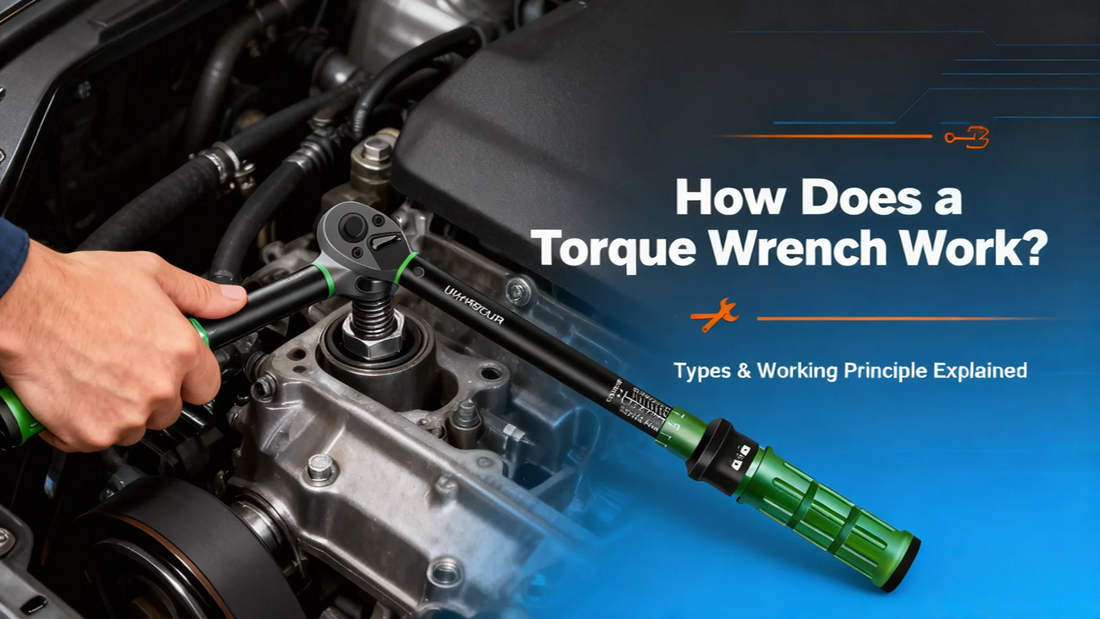
How Does a Torque Wrench Work?
When it comes to assembling machinery, fixing up a car, or even tightening bolts on a bicycle, precision really makes a difference. If you over-tighten a bolt, you risk stripping the threads or damaging parts. If you under-tighten it, the fastener may loosen over time — and that can be just as dangerous.
That’s exactly why we use a torque wrench. It’s a tool designed to apply just the right amount of twisting force, or torque, to a nut or bolt. But how does it actually work in practice? Let’s take a closer look at the torque wrench working principle, the different types available, and why this knowledge matters.
What Is a Torque Wrench?
A torque wrench is essentially a hand tool that lets you tighten bolts and nuts to a precise torque value. Torque is simply the twisting force you apply to a fastener. By using the correct torque, you ensure proper clamping force — strong enough to hold things together, but not so tight that it causes damage.
This is especially important in areas like automotive repair, aerospace, heavy equipment, and even DIY projects. It’s no surprise that so many people look up how to use a torque wrench before tackling a job that requires accuracy.
The Torque Wrench Working Principle
At its core, a torque wrench works on the principle of controlled leverage with a calibrated mechanism that tells you when you’ve reached the desired torque. No matter the type, the goal is always the same: measure the resistance as you turn and stop you at the right moment.
1. Click-Type Torque Wrench
This is the type you’ll see most often:
- You set the torque value on the handle.
- As you tighten, the internal spring compresses.
- Once the target torque is reached, the mechanism “slips” and makes a clear click.
- That click is your signal to stop.
👉 A favorite among beginners because it gives you instant feedback.
2. Beam-Type Torque Wrench
A more traditional but still very reliable design:
- The handle is connected to a steel beam that flexes as you apply force.
- A pointer attached to the beam moves across a scale.
- The scale shows you the torque you’re applying in real time.
- You stop when the pointer lines up with your target value.
👉 Extremely durable and accurate, though it does require you to keep an eye on the scale while working.
3. Digital Torque Wrench
The modern, high-tech option:
- Uses a strain gauge to measure the force applied.
- A microprocessor calculates the torque.
- The value shows up on a digital screen.
- Many models also beep or vibrate when you hit the target torque.
👉 Ideal for professionals who need precision — and often, a digital record of the torque applied.
Why the Torque Wrench Working Principle Matters
Knowing how your torque wrench works isn’t just a “nice to have.” It builds confidence and helps you get the job done right.
- Accurate torque protects engines and machinery by keeping fasteners within manufacturer specs.
- Consistent clamping force ensures even pressure, which is critical in industries like aerospace and construction.
- Better safety means fewer failures caused by bolts that are too loose or too tight.
Whether you’re just learning how to use a torque wrench or weighing the pros and cons of different types of torque wrenches, understanding the principle is key.
Conclusion
A torque wrench may not look fancy at first glance, but it’s a tool that blends simple leverage with precise mechanics — or in the case of digital models, electronics. Whether it’s the click of a spring, the flex of a steel beam, or the beep of a digital alert, the message is the same: you’ve reached the right torque, now stop.
Getting comfortable with the torque wrench working principle means finding the balance between strength and accuracy. That’s a skill every mechanic, engineer, or DIY enthusiast should master.
👉 If you’re ready to take the next step, explore our full range of high-quality torque wrenches and other precision fastening tools on our website: https://uharbourtools.com/. You’ll find expert advice, product guides, and solutions designed to help you work smarter and safer.
